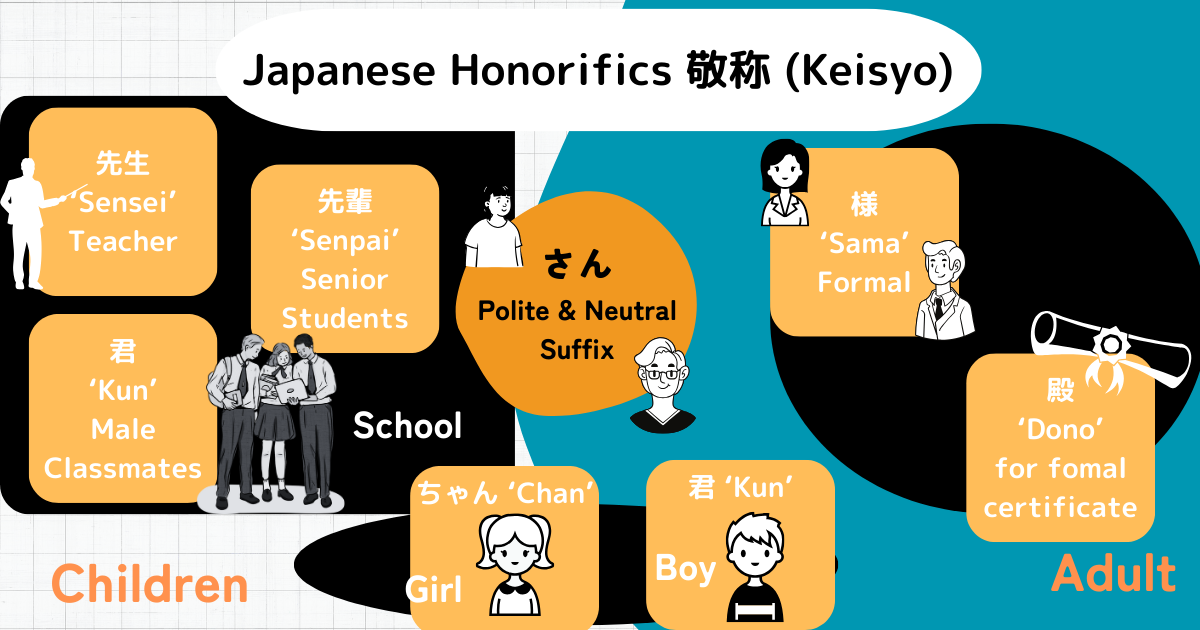
Honorifics? What are they??

Good question, Len. Honorifics can be translated to 敬称 (Keisyo) in Japanese.

Okay, so what is 敬称 (Keisyo) then?

I would say, 敬称 (Keisyo) is a term used to refer to someone in order to show respect or politeness towards others.
Didn’t you think it sounded very Japanese, trying to show respect or politeness towards others? Yes, I absolutely agree with you. We’re definitely a little like English people, who love to talk politely.
But if you think about “Mr,” “Mrs,” or “Miss,” they are the 敬称 (Keisyo) in Japanese. So, it’s not anything difficult or complicated. Let’s explore more details!
The Significance of 敬称 (Keisyo)
In Japanese culture, ‘Keisyo’ plays a pivotal role in maintaining harmonious social relationships as it helps deliver a speaker’s respect, politeness, and familiarity with the person they are addressing or referring to.
Common 敬称 (Keisyo) in Japanese
さん (San) -most well-known Keisyo
‘さん’ is one of the most well-known keisyo in Japanese. It’s a polite and neutral suffix used when talking to someone. You can use it in formal situations, and in everyday conversations. For instance, if someone’s name is Tanaka, you can call them ‘Tanaka-san’ to be polite.
As a Japanese person who grew up in Japan, I used to use ‘さん’ to address my classmates wasn’t very close to. However, one thing I need to point out is that, at school, you don’t usually call male classmates with ‘さん’; it should be ‘くん.’
‘さん’ is very useful at work as well. You can call your colleagues by their surnames followed by ‘さん.’ Importantly, it is not gender-specific at work, so there’s no issue in using it for male or female colleagues.
様 (Sama) -Keisyo for formal situations
“様” (sama) is a keisyo that’s used in very formal situations. It shows a lot of respect. People often use it in business, especially when talking to customers or in formal written messages. For example, when addressing a client, you might say “Tanaka-sama” to be very polite.
君 (Kun) -Keisyo mostly for boys
“君” (kun) is used when talking to someone you’re close to or have a casual relationship with. It’s often used among friends, people of a similar age, or peers. For example, you might say “Taro-kun” when talking to a friend. This suffix is most commonly used for addressing boys or men.
As I mentioned earlier, ‘君’ is an appropriate suffix to use to address your male classmates.
先生 (Sensei) -Keisyo, title for teachers
“先生” (sensei) is a title used for teachers, professionals, or people who are highly skilled in their respective fields. It’s a way of showing a lot of respect and acknowledging their expertise. For instance, when you call a teacher “Miyagi-sensei,” it’s a way of being polite and showing respect.
先輩(Senpai) -Keisyo for someone senior
A “先輩” (senpai) is someone who is more experienced or senior to you in a particular setting, like school or work. It’s a way to acknowledge their seniority and show respect towards them. For example, you might call an older student “Yamada-senpai” as a sign of respect.
殿 (Dono) -Keisyo mostly for fomal certificate
“殿” (dono) is a keisyo, in Japanese that was historically used to address individuals of high rank or social status, such as nobility or samurai. While it’s considered archaic in everyday spoken language and less commonly used in modern times, it still has a presence in formal written Japanese, especially in certain types of documents.
You may see ‘殿’ on your ‘graduation certificate’ or any other official certificate. It will follow your name, such as ‘山田太郎殿’ (Yamada Taro-dono).

There are so many of them!

Yes, I know. We looked at some Keisyo which actually show your respect and pliteness. But,

Oh no, are you going to say there are more ?

Don’t be scared, Len! I want to mention just one more to address your affection or familiality rather than pliteness.
ちゃん (Chan) -adorable and endearing Keisyo
“ちゃん” (chan) stands out as an adorable and endearing suffix. Unlike other more formal honorifics, “chan” is often used to convey affection and familiarity. It’s commonly attached to the names of children, close friends, and even pets. When you use “chan,” it adds a sense of warmth and closeness. For example, calling your friend Ayumi “Ayumi-chan” adds a touch of affection to the name, making it feel more personal. “Chan” is a popular choice when addressing young children and can be a way to express care and fondness in your conversations.
My parents, sister, and close friends still call me with ‘ちゃん,’ even though I’m in my late 40s. I really like it!
Challenges for learners, but conquerable!
So, how do you feel about Japanese honorifics? Are you feeling daunted or better than you thought originally?
I understand if you see the list of Keisyo, you may feel overwhelmed, but please don’t be fooled by it.
Learning how to use “keisyo” effectively can be one of the tricky parts of studying Japanese. It means understanding how to be polite and show respect in different situations, which can be quite challenging. Even native speakers sometimes find it hard to use “keisyo” correctly.
For learners, the key is to take it step by step. You should practice in real conversations and try talking with native speakers. Getting involved in Japanese culture can help you understand the little details of “keisyo” and how to use them right.
Summery -Keisyo
Keisyo is an important part of Japanese manners that show respect and politeness, and sometimes affection! Learning how to use it right can make your conversations in Japanese more meaningful and respectful. It’s a key part of connecting with the language and its people, giving learners a better insight into Japanese culture.
Lastly, if you’ve enjoyed the article, you might also like my YouTube channel, Animated Japanese, where you can learn Hiragana characters. Learning a foreign language can be daunting, but the videos on my channel aim to make it a fun and enjoyable experience! Don’t miss out on this opportunity!




コメント